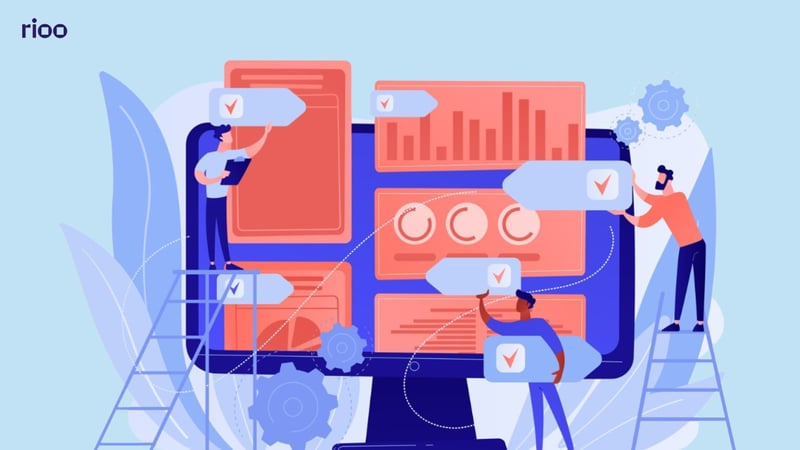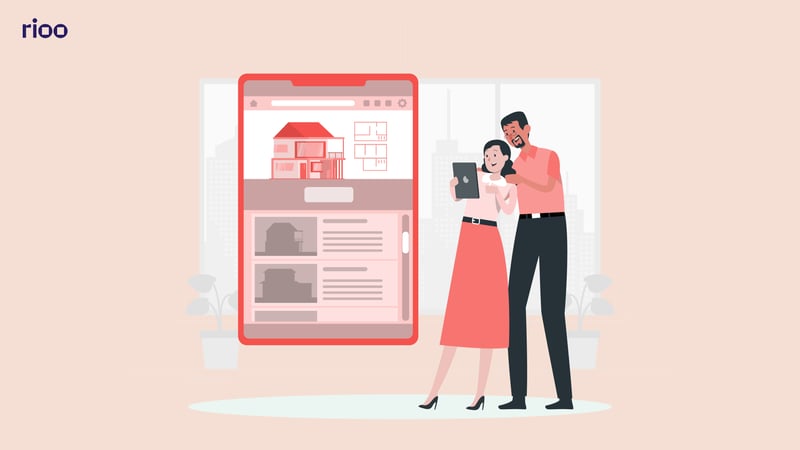Imagine managing dozens or even hundreds of properties with separate spreadsheets, scattered maintenance requests, and unclear financial reports.
Sound overwhelming? That’s the reality for many property managers who still rely on outdated systems. But facility management software is changing how property portfolios are handled by consolidating everything in one place.
The global market for property management software is booming. It is expected to grow from $3.2 billion in 2023 to $7.8 billion by 2033, driven by the urgent need for operational efficiency and cost control.
In this article, we’ll explore the top 5 benefits of facility management software and show you how adopting a unified platform like RIOO can help you streamline operations, save money, and scale your properties with ease.
Key Takeaways
- Facility management software centralizes property operations, boosting efficiency and reducing manual tasks across residential and commercial portfolios.
- Preventive maintenance and energy optimization significantly lower operating costs, delivering measurable ROI for property managers.
- Advanced asset monitoring and predictive maintenance extend the lifespan of critical equipment, preventing costly breakdowns.
- Automated compliance management ensures regulatory requirements are consistently met, reducing risks and audit burdens.
- Data-driven insights empower strategic decisions, helping you optimize portfolio performance and plan for sustainable growth.
What Is Facility Management Software and Why Do You Need It?
Facility management software is a cloud-based platform that brings together all critical property management tasks.
Whether it’s tracking lease agreements, managing maintenance, or monitoring finances, the software centralizes everything in one easy-to-use system.
Here’s what you get with modern facility management software:
- Comprehensive asset and maintenance management: Schedule and track repairs instantly to avoid costly downtime.
- Leasing and tenant communication: Streamline lease renewals and tenant requests with automated workflows.
- Financial tracking and reporting: Get real-time insights into income, expenses, and budgets.
- Compliance and safety management: Monitor regulatory requirements and inspection schedules effortlessly.
- Space optimization tools: Manage space use efficiently to reduce vacancies and increase revenue.
Also Read: What is Facility Management: Understanding Roles & Practices
Benefit 1: Boost Operational Efficiency and Productivity
Are routine tasks slowing you down? Facility management software automates many daily operations that used to take up hours or even days. From maintenance requests to lease renewals, automation reduces manual errors and speeds up workflow.
Key efficiency boosters include:
- Automated maintenance scheduling: Automatically generate and assign work orders.
- Centralized data access: Access property info, tenant communication, and financials from one place.
- Mobile capabilities: Field teams get real-time updates on maintenance via smartphones.
- Proactive management: Shift from reacting to problems to preventing them with automated alerts.
Imagine how much time and money you’ll save by having your entire portfolio managed efficiently.
Also Read: Automated Facility Management System: Where Smart Tech Meets Daily Operations
Benefit 2: Slash Costs and Maximize Your ROI
Cost control is a major headache for property managers. A single emergency repair or energy waste can seriously eat into your profits. Facility management software helps you cut costs with preventive maintenance and data-driven financial management.
Here’s how it lowers expenses:
- Preventive maintenance: Reduces emergency repairs by 30-40%, saving costly downtime.
- Energy optimization: Tracks utility usage to identify savings opportunities.
- Vendor management: Streamlines contracts and bulk purchases.
- Space utilization: Optimizes property layout to cut vacancy costs.
- Automated financial reporting: Reduces administrative effort and errors.
On average, organizations see a reduction in operational costs with facility management software. Plus, preventive maintenance can save three to five times the cost of emergency repairs.
Also Read: How to Efficiently Assess Condition in Facility Management
Benefit 3: Extend Asset Lifespan and Prevent Failures
Assets like HVAC systems, elevators, and security equipment are costly to replace. Managing their maintenance properly extends their lifespan and prevents breakdowns.
Facility management software leverages IoT and predictive analytics for smarter asset management.
Advantages include:
- Real-time asset monitoring: IoT sensors alert you before failures occur.
- Predictive maintenance scheduling: Repairs are done based on condition, not just calendar dates.
- Maintenance history tracking: Helps identify recurring issues and plan upgrades.
- Usage pattern analysis: Optimize asset use to prevent premature wear.
- Mobile inspection tools: Document asset health on-site with photos and notes.
RIOO’s platform integrates with smart building technologies, giving you a 360-degree view of asset health across residential and commercial properties. This unified tracking means no asset gets overlooked.
Ready to protect your property investments with smart technology? Contact RIOO now and implement predictive maintenance for lasting results.
Benefit 4: Ensure Compliance and Manage Risks with Confidence
Compliance isn’t optional; it’s critical. Facility management software automates compliance tracking, helping you stay ahead of regulations and avoid penalties.
It also improves workplace safety by managing inspections and risk assessments digitally.
Key compliance features:
- Automated tracking: Reminders for inspections and license renewals.
- Digital audit trails: Easily prove compliance during audits.
- Safety inspection workflows: Schedule and record safety checks.
- Risk assessment tools: Identify hazards and mitigate risks before incidents occur.
- Insurance documentation: Streamline claims with proper records.
Also Read: Smart Building Technology in Facility Management
Benefit 5: Make Data-Driven Decisions for Strategic Growth
Data is your greatest asset for scaling your property portfolio. Facility management software offers advanced analytics that transform raw property data into actionable business insights.
Data advantages include:
- Custom dashboards: Track KPIs like occupancy, leasing trends, and cost efficiency.
- Performance benchmarking: Compare different properties to identify improvement areas.
- Forecasting: Predict market trends and maintenance needs.
- Tenant satisfaction analytics: Understand and improve tenant retention.
- Financial ROI analysis: Measure the impact of investments and capital improvements.
Also Read: How Does Property Management Software Improve Tenant Satisfaction in Real Life?
Implementation Best Practices for Facility Management Software
Implementing facility management software is a game-changer, but it comes with challenges. Understanding common hurdles and applying best practices ensures a smooth transition and maximizes your software’s value.
Common Challenges:
- Resistance to change: Staff accustomed to legacy systems may hesitate to adopt new technology.
- Integration issues: Connecting new software with existing tools like accounting or CRM systems can be complex.
- Data migration: Transferring historical data accurately is critical but often tricky.
- Training gaps: Users need tailored training to become proficient quickly.
- Resource allocation: Implementation requires time and personnel, which can strain operations initially.
Solutions:
- Executive buy-in: Leadership support drives adoption and facilitates resource availability.
- Phased rollout: Start with critical functions before expanding across the portfolio.
- Experienced partners: Work with vendors who provide hands-on implementation guidance.
- Clear communication: Keep employees informed about benefits and progress.
- Continuous training: Provide ongoing support through workshops and tutorials.
Change Management Strategies
Navigating change starts with empathy. Engage employees early, listen to their concerns, and highlight how software will lighten workloads.
Create super-users, enthusiasts who champion the platform, and foster a culture of collaboration.
Set measurable goals and celebrate early wins to build momentum.
Also Read: Essential KPIs in Facility Management for Success
Choosing the Right Facility Management Software for Enterprise Portfolios
Selecting facility management software for a medium to enterprise-level portfolio is a critical decision that shapes your operational success.
Key Selection Criteria:
- Scalability: Can the system grow as you add properties or expand regions? Look for platforms built to handle thousands of units across multiple asset types.
- Integration capabilities: The software should seamlessly connect with existing financial, leasing, and communication tools to avoid fragmented data.
- Mobile accessibility: Field teams need real-time access from smartphones or tablets for on-the-go updates and maintenance management.
- Compliance and security: Ensure the platform supports multi-jurisdictional compliance requirements and employs robust data security protocols.
- User experience: A user-friendly interface minimizes training time and boosts adoption among diverse teams.
- Vendor support: Reliable customer service and hands-on implementation assistance are essential for a smooth transition and ongoing success.
RIOO exemplifies these criteria by offering a unified, cloud-based platform designed specifically for the complexities of large, mixed portfolios.
With global scalability and integrated financial dashboards, RIOO ensures your entire portfolio is managed efficiently and transparently.
Choosing RIOO means investing in a future-proof system that grows with your business. Want to make an informed choice?
Contact RIOO today for a personalized demo and expert consultation.
Conclusion
Facility management software has become indispensable for property managers looking to boost efficiency, cut costs, and scale their portfolios. From automating routine tasks to offering predictive maintenance and compliance tools, the benefits are clear.
Don’t let outdated systems hold you back. Take control of your property portfolio with RIOO, the comprehensive, cloud-based solution designed for today’s complex property landscape.
Ready to transform your property management?
Frequently Asked Questions
1. What is facility management software?
It’s a cloud-based platform that integrates property operations like maintenance, leasing, finances, and compliance into one system, simplifying management.
2. How does facility management software save money?
By automating preventive maintenance, reducing emergency repairs, optimizing energy use, and improving vendor management, it cuts operating costs significantly.
3. Can this software handle both commercial and residential properties?
Yes, modern solutions like RIOO are designed to manage diverse portfolios, including mixed commercial and residential assets, seamlessly.
4. Is facility management software difficult to implement?
Implementation challenges exist but can be overcome with phased rollouts, clear communication, and expert vendor support to ensure smooth adoption.
5. Will my data be secure?
Top platforms use robust security measures, encryption, access controls, and compliance with global data standards to protect your information.
6. Does it help with regulatory compliance?
Absolutely. Software automates inspection scheduling, tracks documentation, and generates audit trails to ensure you meet legal requirements.
7. How mobile-friendly is the software?
Most facility management software offers mobile access, letting your team manage tasks anytime, anywhere, for greater productivity.
8. Will it integrate with my existing systems?
Yes, integration capabilities are standard, enabling seamless connection with financial, leasing, and other business tools.















